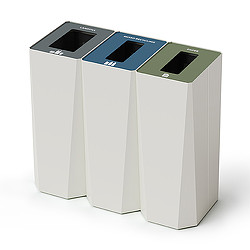Designed for durability, repair, retrofit, recycling
Designing products to ensure that they can be upgraded, remanufactured, and or recycled. Products shall be designed in a modular fashion to facilitate the repair or replacement of components that are subject to wear or breakage or likely to be upgraded. Maximize the degree to which materials from the product that cannot be reused or remanufactured can be recycled. Provide verification of recyclability of other constituent materials in accordance with the U.S. Federal Trade Commission Green Guides or in accordance with applicable environmental marketing guidelines in the country in which the product is manufactured.
SOURCE: BIFMA e3-2019
End of Life Options
Refers to the various ways a product or material may be disposed of, repurposed, repaired, recycled, downcycled, or recirculated. Examples include: designed for durability/repair/retrofit/recycling, design for recyclability, extended producer responsibility programs (manufacturer take back programs), products as services, closed loop recycling programs, third-party partnerships for product recovery and cycling.
Environmental Product Declaration
An Environmental Product Declaration (EPD) is a standardized document prepared by a manufacturer that reports objective, comparable and third-party verified information on the environmental impact of a product or system over the course of its lifecycle in accordance with ISO 14025, ISO 21930, or EN 15804. Environmental impacts reported in an EPD include a product’s Global Warming Potential.
Extended Producer Responsibility Program
An EPR Program consists of measures undertaken by the maker of a product to accept its own and sometimes other manufacturers’ products as post-consumer waste at the end of the products’ useful life. Producers recover and recycle the materials for use in new products of the same type. For carpet, extended producer responsibility must be consistent with NSF/ANSI 140–2007. Also known as closed-loop program or product take-back.
SOURCE: USGBC
Global Warming Potential
The Global Warming Potential (GWP) is a standardized unit of measure of contribution to the greenhouse effect driving climate change. Specifically, it is a measure of how much energy the emissions of 1 ton of gas will absorb over a given period of time, relative to the emissions of 1 ton of carbon dioxide (CO2).
High-Density Mineral Wool Batt & Board
Any mineral wool batt or board insulation with a density of between 4.4-8 lbs/ft3 (70-128 kg/m3)
Inherently Nonemitting Sources
Products that are inherently nonemitting sources of VOCs (stone, ceramic, powder-coated metals, plated or anodized metal, glass, concrete, clay brick, and unfinished or untreated solid wood) are considered fully compliant without any VOC emissions testing if they do not include integral organic-based surface coatings, binders, or sealants. Untreated and unfinished solid wood (not engineered wood) can also be considered nonemitting even though such materials will likely emit some amount of formaldehyde naturally.
SOURCE: USGBC
Ingredient Disclosure
Assessments that provide an inventory of all ingredients present in a material or product, identified by name and the CASRN and/or EC Number, and checked against a relevant database for potential health and environmental hazards.
LBC Red List 3.1
The Living Building Challenge (LBC) Red List represents the “worst in class” materials, chemicals, and elements known to pose serious risks to human health and the greater ecosystem that are prevalent in the building products industry. Compliance with this criteria may be met through a manufacturer’s letter of assurance that a product has been screened for and does not contain red list ingredients at a minimum disclosure threshold of 1000ppm.
SOURCE: The Living Building Challenge (LBC) Red List
Life Cycle Assessment (LCA)
A standardized way of quantifying the environmental impact of a product or system, including but not limited to embodied carbon. LCAs must be conducted in accordance with ISO 14044, and report a product’s Global Warming Potential.
Life-Cycle Assessment (LCA) Optimization
A compliant embodied carbon optimization report or action plan, separate from the LCA or EPD, that demonstrates reductions in environmental impacts over time.
SOURCE: USGBC
Low-Density Mineral Wool Batt & Board
Any mineral wool batt or board insulation with a density of less than 4.4 lbs/ft3 (<70 kg/m3)
Manufacturer Location
The facility in which the final assembly of a product occurs. In a Life-Cycle Assesment, this would be the final facility before the A4 phase.
Multi-Attribute Certification
These are certifications measuring multiple areas of sustainability including but not limited to: embodied carbon, material health, indoor emissions, social fairness, product circularity, and water use.
Multi-attribute certifications such as Cradle to Cradle v.4 and Living Product Challenge may satisfy the standard requirements for Indoor Air Impacts, Material Health & Transparency, and Lifecycle Impacts, except EPD requirements where applicable. Product categories with EPD requirements and/or Global Warming Potential (GWP) thresholds are still required to provide EPDs and disclose the GWP of the product via a third-party verified EPD, regardless of multi-attribute certification.
Organizational Commitments
Environmental commitments made at an organizational or company-wide level . This is not intended to be an exhaustive list, and therefore equivalent programs and/or pledges may be recognized as fulfilling this criteria.
Post-Consumer Recycled Content
Waste generated by households or commercial, industrial and institutional facilities in their role as end users of a product that can no longer be used for its intended purpose.
SOURCE: USGBC
Pre-Consumer/Post-Industrial Recycled Content
Matter diverted from the waste stream during the manufacturing process, determined as the percentage of material, by weight. Examples include planer shavings, sawdust, bagasse, walnut shells, culls, trimmed materials, overissue publications, and obsolete inventories. The designation excludes rework, regrind, or scrap materials capable of being reclaimed within the same process that generated them (ISO 14021). Formerly known as postindustrial content.
SOURCE: USGBC
Product as Service
Physical product and services to maintain a product's use through design, use, maintenance, reuse, remanufacture, and recycling.
SOURCE: Article
Science Based Targets Initiative
The Science Based Targets initiative (SBTi) promotes best practices and well-defined guidelines to reduce emissions and provides target-setting methods based on climate science. The initiative helps businesses set carbon reduction goals compliant with the Paris Agreement Targets. Science-Based Targets (SBTs) focus on the number of emissions that needs to be decreased to comply with the targets set out in the Paris Climate Agreement
SOURCE: Science Based Targets
Self-Disclosed Manufacturer Inventory
A publicly available inventory of all ingredients identified by name and Chemical Abstract Service Registration Number (CASRN) and/or European Community Number (EC Number). Materials defined as trade secret or intellectual property may withhold the name and/or CASRN/EC Number but must disclose ingredient/chemical role, amount and hazard score/class using either: Greenscreen List Translator (LT) score and/or Full GreenScreen Benchmark (BM), The Globally Harmonized System of Classification and Labeling of Chemicals rev.6 (2015) (GHS). The hazard screen must be applied to each trade secret ingredient and the inventory lists the hazard category for each of the health hazards included in Part 3 of GHS (e.g. “GHS Category 2 Carcinogen”).
SOURCE: USGBC
Sustainability Action Plan
A publicly available action plan or statement addressing your company’s commitment to sustainable practices with clear actions intended to be met within a defined timeframe.
A volatile organic compound (VOC) is any compound of carbon, excluding carbon monoxide, carbon dioxide, carbonic acid, metallic carbides or carbonates, and ammonium carbonate, which participates in atmospheric photochemical reactions. As gases, VOCs are emitted into the air from products or processes and are often harmful to human health and to the environment by themselves, as well as by reacting with other gases to form other air pollutants after they are in the air.




















